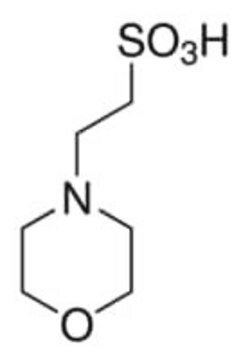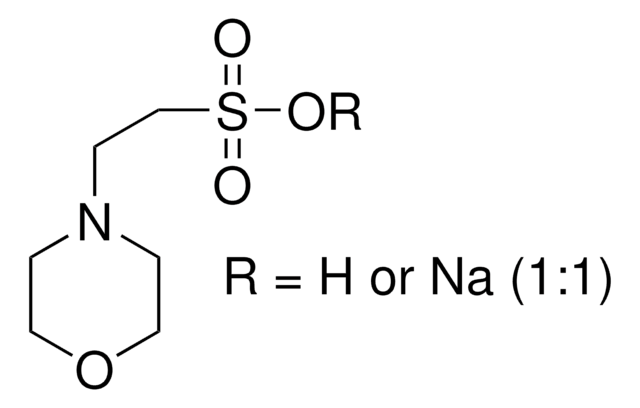76039
MES solution
BioUltra, for molecular biology, 0.5 M in H2O
About This Item
Recommended Products
grade
for molecular biology
Quality Level
product line
BioUltra
form
liquid
concentration
0.5 M in H2O
pH
2.5-4.0 (25 °C in neat)
anion traces
chloride (Cl-): ≤10 mg/kg
sulfate (SO42-): ≤10 mg/kg
cation traces
Al: ≤1 mg/kg
Ba: ≤1 mg/kg
Bi: ≤1 mg/kg
Ca: ≤5 mg/kg
Cd: ≤1 mg/kg
Co: ≤1 mg/kg
Cr: ≤1 mg/kg
Cu: ≤1 mg/kg
Fe: ≤1 mg/kg
K: ≤20 mg/kg
Li: ≤1 mg/kg
Mg: ≤1 mg/kg
Mn: ≤1 mg/kg
Mo: ≤1 mg/kg
Na: ≤20 mg/kg
Ni: ≤1 mg/kg
Pb: ≤1 mg/kg
Sr: ≤1 mg/kg
Zn: ≤1 mg/kg
λ
neat
UV absorption
λ: 260 nm Amax: 0.01
λ: 280 nm Amax: 0.01
SMILES string
OS(=O)(=O)CCN1CCOCC1
InChI
1S/C6H13NO4S/c8-12(9,10)6-3-7-1-4-11-5-2-7/h1-6H2,(H,8,9,10)
InChI key
SXGZJKUKBWWHRA-UHFFFAOYSA-N
Application
- Nanometric determination of the thickness of aqueous samples for accurate molar absorption coefficients of water-soluble molecules in the mid-infrared region.: This study utilizes MES solution as a buffering agent to achieve precise thickness measurements of aqueous samples. The accurate molar absorption coefficients obtained enhance the reliability of spectroscopic analyses in biochemical research (Gutierrez-Salazar & Lorenz-Fonfria, 2024).
- pH-Responsive Nanogels Generated by Polymerization-Induced Self-Assembly of a Succinate-Functional Monomer.: This research employs MES solution to maintain the desired pH environment during the synthesis of pH-responsive nanogels. The study highlights the potential applications of these nanogels in drug delivery systems (Du & Fielding, 2024).
Storage Class Code
10 - Combustible liquids
WGK
WGK 1
Flash Point(F)
Not applicable
Flash Point(C)
Not applicable
Regulatory Listings
Regulatory Listings are mainly provided for chemical products. Only limited information can be provided here for non-chemical products. No entry means none of the components are listed. It is the user’s obligation to ensure the safe and legal use of the product.
JAN Code
76039-BULK-F:
76039-100ML-F:
76039-500ML-F:
76039-VAR-F:
Choose from one of the most recent versions:
Already Own This Product?
Find documentation for the products that you have recently purchased in the Document Library.
Customers Also Viewed
Our team of scientists has experience in all areas of research including Life Science, Material Science, Chemical Synthesis, Chromatography, Analytical and many others.
Contact Technical Service





